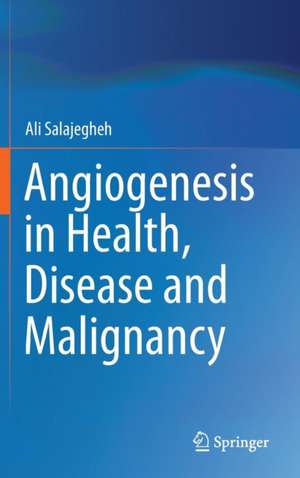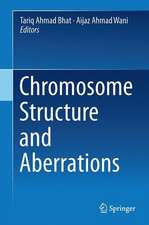Angiogenesis in Health, Disease and Malignancy
Autor Ali Salajeghehen Limba Engleză Hardback – 22 mar 2016
The book describes more than 100 genes and their key regulatory functions in the context of normal healthy condition, disease and malignancy, cancer proliferation and progression. New insights into the role of angiogenesis and the therapeutic inhibition of its regulators are investigated, due to the great potential for exploitation in the development of a novel treatment for cancer.
New scientists, junior researchers and biomedical science students will find this book an invaluable introductory reference to their insight about angiogenesis and angiogenic role of more than 100 angiogenes and their role in healthy, disease and malignant conditions.
| Toate formatele și edițiile | Preț | Express |
|---|---|---|
| Paperback (1) | 1102.31 lei 6-8 săpt. | |
| Springer International Publishing – 24 apr 2018 | 1102.31 lei 6-8 săpt. | |
| Hardback (1) | 1109.44 lei 6-8 săpt. | |
| Springer International Publishing – 22 mar 2016 | 1109.44 lei 6-8 săpt. |
Preț: 1109.44 lei
Preț vechi: 1167.83 lei
-5% Nou
Puncte Express: 1664
Preț estimativ în valută:
212.32€ • 219.34$ • 176.70£
212.32€ • 219.34$ • 176.70£
Carte tipărită la comandă
Livrare economică 26 martie-09 aprilie
Preluare comenzi: 021 569.72.76
Specificații
ISBN-13: 9783319281384
ISBN-10: 3319281380
Pagini: 476
Ilustrații: XVIII, 423 p.
Dimensiuni: 155 x 235 x 25 mm
Greutate: 0.79 kg
Ediția:1st ed. 2016
Editura: Springer International Publishing
Colecția Springer
Locul publicării:Cham, Switzerland
ISBN-10: 3319281380
Pagini: 476
Ilustrații: XVIII, 423 p.
Dimensiuni: 155 x 235 x 25 mm
Greutate: 0.79 kg
Ediția:1st ed. 2016
Editura: Springer International Publishing
Colecția Springer
Locul publicării:Cham, Switzerland
Public țintă
ResearchCuprins
1. Introductionto Angiogenesis in Normal Physiology. Disease and Malignancy
2. Adenosine triphosphate-bindingcassette (ABC) lipid transporters
3. Angiogenin
4. Angiopoietins
5. Angiotropin 6. C-KIT: tyrosine kinase receptors withpotential to initiate
7. CCND1 and E1
8. Cluster of Differentiation 71 (CD71)
9. Connective Tissue Growth Factor (CTGF)
10. COX10
11. Cysteine-rich 61 (Cyr61)
12. Epidermal growth factor
13. Epidermal growth factor domain-like 7(EGFL7)
14. Erythropoietin-producinghepatocellular receptors A: Ephrin A1, Ephrin A2 and Ephrin A3
15. Erythropoietin-producinghepatocellular receptors B: Ephrin B2, Ephrin B4
16. Ets-1
17. Fibrin
18. Fibroblastgrowth factors (Acidic: FGF-1; Basic: FGF-2) and its receptors (FGFR)
19. Fibronectin
20. Granulocyte-Macrophageand Granulocyte Colony Stimulating Factor (GM-CSF and G-CSF)
21. GAX and HOXA5
22. Heparanase
23. Hepatocyte Growth Factor (HGF)
24. HIF-1α
25. Insulin-like growth factor
26. Integrins (αv1β3, αv1β5, β8)
27. Interleukins
28. Insulin receptor substrate (IRS1)
29. Iron-sulfur clusters (ISCU)
30. MDM4
31. Matrix Metalloproteinase 2 (MMP2)
32. Monobutyrin
33. Neutrophil activating protein-2 (NAP-2)
34. p27kip1 and p57Kip2 (CDKN1B and CDKN1C)
35. Platelet-derived endothelial cell growthfactor (PDGF)
36. Prolyl hydroxylase domain-2 (PHD-2)
37. Phosphatidylinositol-4, 5-bisphosphate3-kinase (PIK3Ca)
38. PIK3R2 (p85β) - Phosphatidylinositol3-kinase β-subunit
39. Platelet-activating factor
40. Placenta growth factor (PlGF)
41. Preproendothelin-1 (PreproET-1)
42. Proliferin
43. Prostaglandins
44. ROS1
45. SIRT1
46. SMAD4 (Mothers against DecapentaplegicHomolog 4)
47. Sprouty-Related, EVH1 Domain-containingprotein 1 (SPRED-1)
48. Signaltransducer and activator of transcription of 5A and S3 (STAT5 and STATS3)
49. SUFU
50. Tenascins
51. Tissue inhibitor of metalloproteinases 1and 2 (TIMP-1 and TIMP-2) 52. Tissue factor gene
53. Transforming growth factor α and β (TGF-α and TGF- β)
54. Transforming growth factor beta-receptortype II (TGFβR2)
55. TSP-1
56. Tumour necrosis factor-α (TNF-α)
57. Urokinase plasminogen activator
58. Vascular Endothelial Growth Factor(VEGF)
59. Vascular cell adhesion molecule-1(VCAM-1)
60. Vascular endothelial (VE)-Cadherin
61. Zinc Finger E-Box Binding Homeobox 1(ZEB1)
62. Miscellaneousgenes involved in Angiogenesis in Normal Physiology, Disease and Malignancy
2. Adenosine triphosphate-bindingcassette (ABC) lipid transporters
3. Angiogenin
4. Angiopoietins
5. Angiotropin 6. C-KIT: tyrosine kinase receptors withpotential to initiate
7. CCND1 and E1
8. Cluster of Differentiation 71 (CD71)
9. Connective Tissue Growth Factor (CTGF)
10. COX10
11. Cysteine-rich 61 (Cyr61)
12. Epidermal growth factor
13. Epidermal growth factor domain-like 7(EGFL7)
14. Erythropoietin-producinghepatocellular receptors A: Ephrin A1, Ephrin A2 and Ephrin A3
15. Erythropoietin-producinghepatocellular receptors B: Ephrin B2, Ephrin B4
16. Ets-1
17. Fibrin
18. Fibroblastgrowth factors (Acidic: FGF-1; Basic: FGF-2) and its receptors (FGFR)
19. Fibronectin
20. Granulocyte-Macrophageand Granulocyte Colony Stimulating Factor (GM-CSF and G-CSF)
21. GAX and HOXA5
22. Heparanase
23. Hepatocyte Growth Factor (HGF)
24. HIF-1α
25. Insulin-like growth factor
26. Integrins (αv1β3, αv1β5, β8)
27. Interleukins
28. Insulin receptor substrate (IRS1)
29. Iron-sulfur clusters (ISCU)
30. MDM4
31. Matrix Metalloproteinase 2 (MMP2)
32. Monobutyrin
33. Neutrophil activating protein-2 (NAP-2)
34. p27kip1 and p57Kip2 (CDKN1B and CDKN1C)
35. Platelet-derived endothelial cell growthfactor (PDGF)
36. Prolyl hydroxylase domain-2 (PHD-2)
37. Phosphatidylinositol-4, 5-bisphosphate3-kinase (PIK3Ca)
38. PIK3R2 (p85β) - Phosphatidylinositol3-kinase β-subunit
39. Platelet-activating factor
40. Placenta growth factor (PlGF)
41. Preproendothelin-1 (PreproET-1)
42. Proliferin
43. Prostaglandins
44. ROS1
45. SIRT1
46. SMAD4 (Mothers against DecapentaplegicHomolog 4)
47. Sprouty-Related, EVH1 Domain-containingprotein 1 (SPRED-1)
48. Signaltransducer and activator of transcription of 5A and S3 (STAT5 and STATS3)
49. SUFU
50. Tenascins
51. Tissue inhibitor of metalloproteinases 1and 2 (TIMP-1 and TIMP-2) 52. Tissue factor gene
53. Transforming growth factor α and β (TGF-α and TGF- β)
54. Transforming growth factor beta-receptortype II (TGFβR2)
55. TSP-1
56. Tumour necrosis factor-α (TNF-α)
57. Urokinase plasminogen activator
58. Vascular Endothelial Growth Factor(VEGF)
59. Vascular cell adhesion molecule-1(VCAM-1)
60. Vascular endothelial (VE)-Cadherin
61. Zinc Finger E-Box Binding Homeobox 1(ZEB1)
62. Miscellaneousgenes involved in Angiogenesis in Normal Physiology, Disease and Malignancy
Textul de pe ultima copertă
This book is about “Angiogenesis”. A process in which new vasculature is formed from pre-existing capillaries. Angiogenesis process is associated with the proliferation and growth of both physiologically normal and neoplastic tissues, through the formation of vascular supply, essential for delivering growth requirements such as oxygen and nutrients.
The book describes more than 100 genes and their key regulatory functions in the context of normal healthy condition, disease and malignancy, cancer proliferation and progression. New insights into the role of angiogenesis and the therapeutic inhibition of its regulators are investigated, due to the great potential for exploitation in the development of a novel treatment for cancer.
New scientists, junior researchers and biomedical science students will find this book an invaluable introductory reference to their insight about angiogenesis and angiogenic role of more than 100 angiogenes and their role in healthy, disease and malignant conditions.
The book describes more than 100 genes and their key regulatory functions in the context of normal healthy condition, disease and malignancy, cancer proliferation and progression. New insights into the role of angiogenesis and the therapeutic inhibition of its regulators are investigated, due to the great potential for exploitation in the development of a novel treatment for cancer.
New scientists, junior researchers and biomedical science students will find this book an invaluable introductory reference to their insight about angiogenesis and angiogenic role of more than 100 angiogenes and their role in healthy, disease and malignant conditions.
Caracteristici
Describes the role of each gene separately in normal, disease and malignant condition
Addresses specifically the role and method of genes' involvement in angiogenesis
Broadens your understanding of angiogenesis, one of the most popular topics of (bio)medical research
Addresses specifically the role and method of genes' involvement in angiogenesis
Broadens your understanding of angiogenesis, one of the most popular topics of (bio)medical research






























